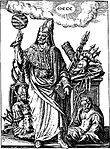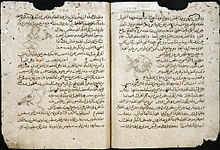Hermes Trismegistus
| Part of a series on |
| Hermeticism |
|---|
 |
| Part of a series on |
| Esotericism |
|---|
 |
Hermes Trismegistus (from
The wisdom attributed to this figure in antiquity combined a knowledge of both the material and the spiritual world, which rendered the writings attributed to him of great relevance to those who were interested in the interrelationship between the material and the divine.[2]
The figure of Hermes Trismegistus can also be found in both
Origin and identity


Hermes Trismegistus may be associated with the Greek god Hermes and the Egyptian god Thoth.[1][3] Greeks in the Ptolemaic Kingdom of Egypt recognized the equivalence of Hermes and Thoth through the interpretatio graeca.[4] Consequently, the two gods were worshiped as one, in what had been the Temple of Thoth in Khemenu, which was known in the Hellenistic period as Hermopolis.[5]
Hermes, the Greek god of interpretive communication, was combined with Thoth, the Egyptian god of wisdom. The Egyptian priest and polymath Imhotep had been deified long after his death and therefore assimilated to Thoth in the classical and Hellenistic periods.[6] The renowned scribe Amenhotep and a wise man named Teôs were coequal deities of wisdom, science, and medicine; and, thus, they were placed alongside Imhotep in shrines dedicated to Thoth–Hermes during the Ptolemaic Kingdom.[7]
The Hermetic literature among the Egyptians, which was concerned with conjuring spirits and animating statues, inform the oldest Hellenistic writings on Greco-
The epithet "thrice great"
Fowden asserts that the first datable occurrences of the epithet "thrice great" are in the Legatio of Athenagoras of Athens and in a fragment from Philo of Byblos, circa AD 64–141.[12] However, in a later work, Copenhaver reports that this epithet is first found in the minutes of a meeting of the council of the Ibis cult, held in 172 BC near Memphis in Egypt.[13] Hart explains that the epithet is derived from an epithet of Thoth found at the Temple of Esna, "Thoth the great, the great, the great."[4]
Many Christian writers, including
Another explanation, in the Suda (10th century), is that "He was called Trismegistus on account of his praise of the trinity, saying there is one divine nature in the trinity."[21]
Hermetic writings
During the
During the Renaissance, it was accepted that Hermes Trismegistus was a contemporary of Moses. However, after Isaac Casaubon's demonstration in 1614 that the Hermetic writings must postdate the advent of Christianity, the whole of Renaissance Hermeticism collapsed.[24] As to their actual authorship:
... they were certainly not written in remotest antiquity by an all wise Egyptian priest, as the Renaissance believed, but by various unknown authors, all probably Greeks, and they contain popular Greek philosophy of the period, a mixture of Platonism and Stoicism, combined with some Jewish and probably some Persian influences.[25]
The French
Various critical editions of the Hermetica have been published in modern academia, such as Hermetica by Brian Copenhaver.
Islamic tradition

The
There are least twenty
Baháʼí writings
References
- ^ S2CID 172059118.
- ISBN 9789004152311. p. 474.
- ^ Budge, E.A. Wallis (1904). The Gods of the Egyptians Vol. 1. pp. 414–5.
- ^ a b Hart, G., The Routledge Dictionary of Egyptian Gods and Goddesses, 2005, Routledge, second edition, Oxon, p 158
- ^ Bailey, Donald, "Classical Architecture" in Riggs, Christina (ed.), The Oxford Handbook of Roman Egypt (Oxford University Press, 2012), p. 192.
- . Retrieved 7 August 2016.
- ^ Thoth or the Hermes of Egypt: A Study of Some Aspects of Theological Thought in Ancient Egypt, p.166–168, Patrick Boylan, Oxford University Press, 1922.
- ^ De natura deorum III, Ch. 56
- ^ "Cicero: De Natura Deorum III". Thelatinlibrary.com. Retrieved 2015-06-25.
- ^ Fowden 1993: pp65–68
- ^ "Stages of Ascension in Hermetic Rebirth". Esoteric.msu.edu. Retrieved 2015-06-25.
- ^ Fowden, G., "The Egyptian Hermes", Cambridge University Press, Cambridge, 1987, p 216
- ^ Copenhaver, B. P., "Hermetica", Cambridge University Press, Cambridge, 1992, p xiv.
- ISBN 978-1-4610-9382-4.
- ^ Jafar, Imad (2015). "Enoch in the Islamic Tradition". Sacred Web: A Journal of Tradition and Modernity. XXXVI.
- ^ Yates, F., "Giordano Bruno and the Hermetic Tradition", Routledge, London, 1964, pp 14–18 and pp 433–434
- ^ Hanegraaff, W. J., "New Age Religion and Western Culture", SUNY, 1998, p 360
- ^ Yates, F., "Giordano Bruno and the Hermetic Tradition", Routledge, London, 1964, p 27 and p 293
- ^ a b Yates, F., "Giordano Bruno and the Hermetic Tradition", Routledge, London, 1964, p52
- ^ Copenhaver, B.P., "Hermetica", Cambridge University Press, 1992, p xlviii
- ^ Copenhaver, Hermetica, p. xli
- ^ Van Bladel 2009, 122ff.
- ^ Principe, L. M., The Secrets of Alchemy, 2013, University of Chicago Press, p. 123
- Hanegraaff, Wouter J.(1996). New Age Religion and Western Culture. Leiden: Brill. pp. 390–391.
- ^ Yates Giordano Bruno and the Hermetic Tradition pp. 2–3
- ^ Mungello 1989:321
- ^ Van Bladel 2009, p. 168: "Abu Mas'har’s biography of Hermes, written approximately between 840 and 860, would establish it as common knowledge."
- ^ (Faivre 1995 pp. 19–20)
- OCLC 706947607. pp. 398–403.
- ^ Van Bladel 2009, p. 17, note 42.
- ISBN 978-3-11-086693-3. p. 46.
- .
- ^ "Hermes Trismegistus and Apollonius of Tyana in the Writings of Bahá'u'lláh". Bahai-library.com. Retrieved 2015-06-25.
Bibliography
- Aufrère, Sydney H. (2008) (in French). Thot Hermès l'Egyptien: De l'infiniment grand à l'infiniment petit. Paris: L'Harmattan. ISBN 978-2296046399.
- Bull, Christian H. 2018. The Tradition of Hermes Trismegistus: The Egyptian Priestly Figure as a Teacher of Hellenized Wisdom. Leiden: Brill. (the standard reference work on the subject)
- CACIORGNA, Marilena and GUERRINI, Roberto: Il pavimento del duomo di Siena. L'arte della tarsia marmorea dal XIV al XIX secolo fonti e simologia. Siena 2004.
- CACIORGNA, Marilena: Studi interdisciplinari sul pavimento del duomo di Siena. Atti el convegno internazionale di studi chiesa della SS. Annunziata 27 e 28 settembre 2002. Siena 2005.
- Copenhaver, Brian P. (1995). Hermetica: the Greek Corpus Hermeticum and the Latin Asclepius in a new English translation, with notes and introduction, Cambridge; New York: Cambridge University Press, 1995 ISBN 0-521-42543-3.
- Ebeling, Florian, The secret history of Hermes Trismegistus: Hermeticism from ancient to modern times [Translated from the German by David Lorton] (ISBN 978-0-8014-4546-0.
- Festugière, A.-J.,La révélation d'Hermès Trismégiste. 2e éd., 3 vol., Paris 1981.
- Fowden, Garth, 1986. The Egyptian Hermes: A Historical Approach to the Late Pagan Mind. Cambridge: Cambridge University Press (Princeton University Press, 1993): deals with Thoth (Hermes) from his most primitive known conception to his later evolution into Hermes Trismegistus, as well as the many books and scripts attributed to him.
- Hornung, Erik (2001). The Secret Lore of Egypt: Its Impact on the West. Translated by David Lorton. Ithaca: Cornell University Press. ISBN 0801438470.
- Lupini, Carmelo, s.v. Ermete Trismegisto in "Dizionario delle Scienze e delle Tecniche di Grecia e Roma", Roma 2010, vol. 1.
- Merkel, Ingrid and ISBN 0-918016-85-1
- ISBN 0-8248-1219-0
- Van Bladel, Kevin (2009). The Arabic Hermes: From Pagan Sage to Prophet of Science. Oxford: ISBN 978-0-19-537613-5. (the standard reference for Hermes in the Arabic-Islamic world)
- Van den Kerchove, Anna 2012. La voie d’Hermès: Pratiques rituelles et traités hermétiques. Leiden: Brill.
- ISBN 0-226-95007-7.
External links
- Corpus Hermeticum along with the complete text of G.R.S. Mead's classic work, Thrice Greatest Hermes
- Hermetic Research is a portal on Hermetic study and discussion
- Dan Merkur, "Stages of Ascension in Hermetic Rebirth"
- Asclepius Archived 2007-01-17 at the Wayback Machine— Latin text of the edition Paris: Henricus Stephanus 1505.
- Pimander—Latin translation by Marsilio Ficino, Milano: Damianus de Mediolano, 1493.
- THE DIVINE PYMANDER of Hermes Mercurius Trismegistus in English
- Online Galleries, History of Science Collections, University of Oklahoma Libraries—High resolution images of works by Hermes Trismegistus in JPEG and TIFF format.

